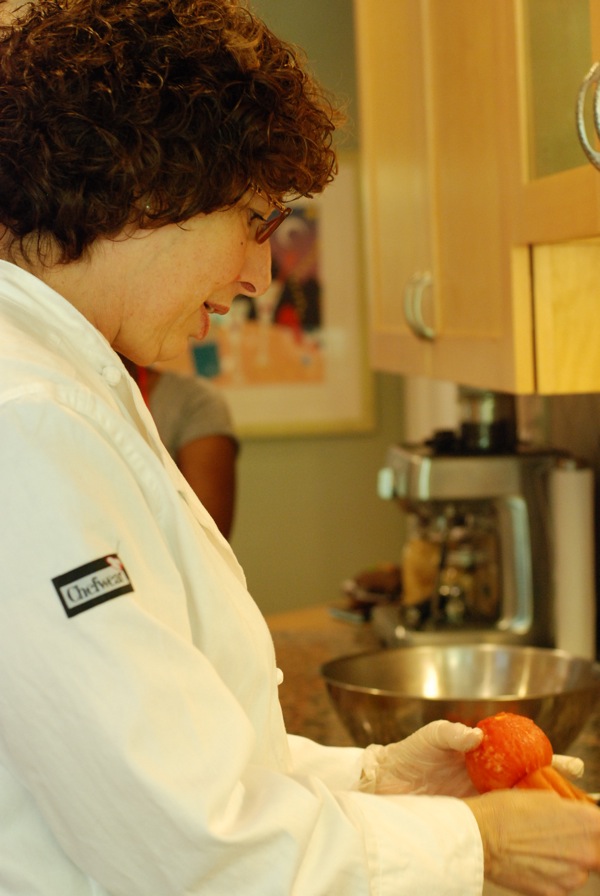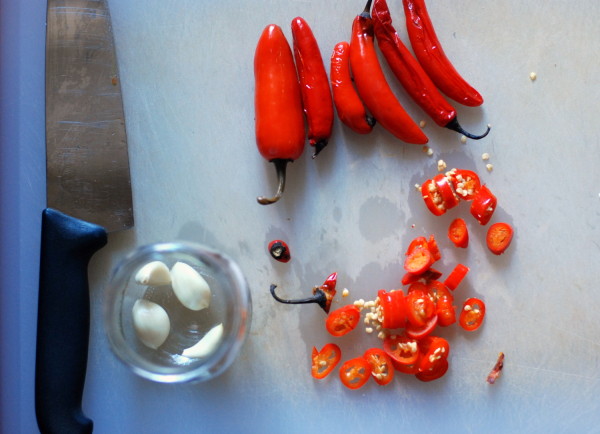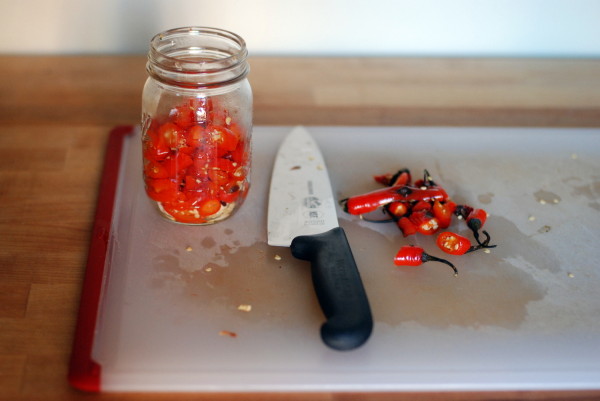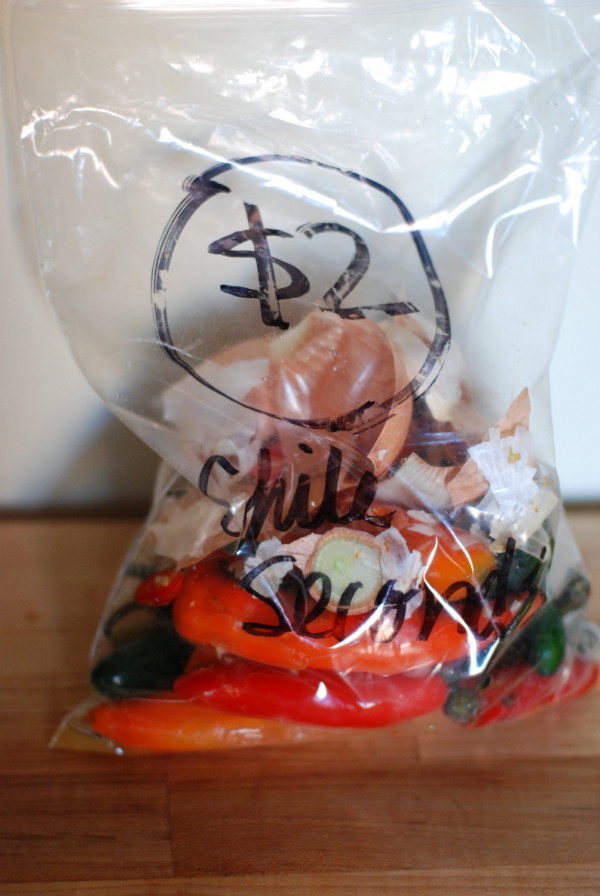These past few weeks can be summed up as an epic attempt to fill our freezer with as much ready-to-eat food as possible. I’ve frozen unbaked scones in little zip-top bags. I’ve filled about ten containers with Persian beef-rice stew and carrot-ginger soup and plenty of chicken stock. I’ve even baked and frozen whole loaf cakes, to defrost for unexpected company. A couple hours this morning and a long day in a low oven produced a batch of Lisa Fain’s chili, which is officially in the freezer.  Still on the cooking wishlist: This lovely eggplant tagine from Blue Apron, which my friend Rachel raved about and for which I have procured all the ingredients. (Stay in, baby, just a little bit longer!). Previously on the wishlist: cookie dough (rolled into balls and frozen unbaked, you know, for emergencies). It was a nice-to-have, but then I woke up at 5 and couldn’t fall back asleep and, well, the cookie dough happened. Thanks, kiddo.
But the whole cook-to-fill-the-freezer thing isn’t new. In truth, my attempts to fill our pantry began back in late summer, when I got to sneak a peek at the galleys of my dear friend Cathy’s book.
Do you know Cathy? She is Mrs. Wheelbarrow, canner, cheesemaker, charcuterie queen, and general goddess of the larder. She was one of the earliest contributors to my beloved Food52, and has penned some of my favorite recipes on the site. She teaches cooking classes out of her home, where I’ve learned to make canned tomatoes, salsa, and all sorts of other canned goodies, as well as goat cheese, feta, and even Camembert. She’s also a hostess extraordinaire, and I’ve been lucky enough to attend many wonderful parties courtesy of her and her husband, Dennis.

Now, after years of blogging, posting on Food52, and writing for Washington Post, New York Times, and more, Cathy’s finally got her own corner of the universe: a book, Mrs. Wheelbarrow’s Practical Pantry.
To give you a sense of this book’s utility, here’s a list of some of the things I’ve made so far: strawberry jam. Tomato sauce. Tomato soup. Grape jelly. Salt-water pickles. Fennel-orange-olive pickles. Marinated artichoke hearts. (Amazing.) Blackberry-hazelnut conserve. Asian plum chutney. Peach-rosemary jam. Since I’m doing this from memory, I’m probably forgetting a few. You get the point: this book has been my constant companion through summer and fall. If you come over this year and I serve you something delicious from a jar, chances are the recipe for it came from Cathy’s book.
But here’s the best part: This isn’t just a preserving book. While the canning and preserving recipes sit at the center, Cathy offers a slew of “bonus” recipes that put your jars to use. A rugelach recipe made with her jam, tortilla lasagna made wither chile-spiked tomatoes, and my personal favorite, inside-out samosas to serve with her fantastic mango chutney. Even if you’re not big on canning, you’ll find plenty to cook, and cook again, in the Practical Pantry.
What most sets Cathy’s book apart is its fearless approach. Cathy is first and foremost a teacher: She wants you to feel her excitement when there’s a deal on second tomatoes or bruised peaches, and armed with this book, you will. You will jump to grab that big bag of $2 chiles, the long, slender box of “basil for pesto,” the bushel of assorted spot-filled apples. You will lug the spoils home, and you will know exactly what to do with them.
Those chiles, for instance, easily become a tangy, slightly sweet hot sauce that you can either can and shelve, or tuck in the fridge and eat immediately. (On everything.) To suit your mood, Cathy offers three different ways to make it: with raw chiles, charred, or smoked.
I first made this hot sauce at one of Cathy’s classes. I got hooked pretty much instantly, and I’ve made it several times since. The recipe has changed a bit since I first encountered it, in one of Cathy’s stapled cooking class handouts; not surprisingly, it’s even better now.
In case it’s not obvious what I think you should do, here it is: make this hot sauce. Buy this book. Then take it to bed one night, read it cover to cover, and bring some sticky tabs, because the next day, you’re going to want to buy everything from the market, and cook this book from front to back.
Congrats, Cathy. It’s gorgeous.
Cathy Barrow’s Any-Chile Hot Sauce
From Mrs. Wheelbarrow’s Practical Pantry
Makes 16 ouncesFor canning purposes, Cathy recommends jarring this in 4-oz. portions. Since I didn’t can this latest batch, I just stored it in a big 8-oz. jar in the fridge.
1/2 pound fresh hot chiles of any kind (red are prettiest; any work with this recipe)
1 cup (8 ounces) white or apple cider vinegar
3 large garlic cloves
1/2 tablespoon kosher salt
2 tablespoons honey
1 1/2 tablespoons minced dried pineapple
1/2 tablespoon minced dried mango
1/4 teaspoon Coleman’s dry mustard
pinch ground gingerPrep the chiles: to use them fresh, carefully stem and roughly chop them. Gloves are helpful here. Alternatively, you can char them in a heavy skillet or griddle over high heat for 6-8 minutes, until blistered all over. Then put them in a bowl, cover, and let steam for 1 hour. Stem and roughly chop (again: gloves). Last option is to smoke them using an electric smoker. Cathy recommends 30 minutes. Stem and chop.
Make the sauce: Combine vinegar, garlic, and salt in a large jar. Shake and swirl to dissolve the salt. Add chiles, cover, and leave on the counter overnight to brine.
Transfer the contents of the jar into a 1.5-quart non-reactive (not copper or aluminum) pot. Add honey, fruit mustard, and ginger. Cover and bring to a strong boil for 3 minutes. Beware of the fumes – you may want to wear a mask for this part.
Puree the sauce in a blender in batches, filling the container only halfway in each batch to avoid explosions. Run your blender long enough to ensure that the sauce is completely smooth.
Press the mixture through a fine-mesh strainer into a bowl. If you find large pieces of chile or garlic in the strainer, you can re-run them through the blender.
Return the sauce to the pot, bring back up to a boil, and boil for 5 minutes. Do not lean over the pot and smell it while this happens – you will regret it. Instead, dip a small spoon into the pot and then taste just a drop. If you want it sweeter or saltier, now is the time to add more honey and/or salt.
When your sauce is ready, either ladle it into sterilized, warm jars leaving 1/2-inch of headspace and process for 10 minutes in a boiling-water bath, or just ladle it into a big jar (preferably with a spout, but not necessary) and store in the fridge.
The sauce is shelf-stable for 1 year when canned, but it may separate; shake well before using.






Comments on this entry are closed.